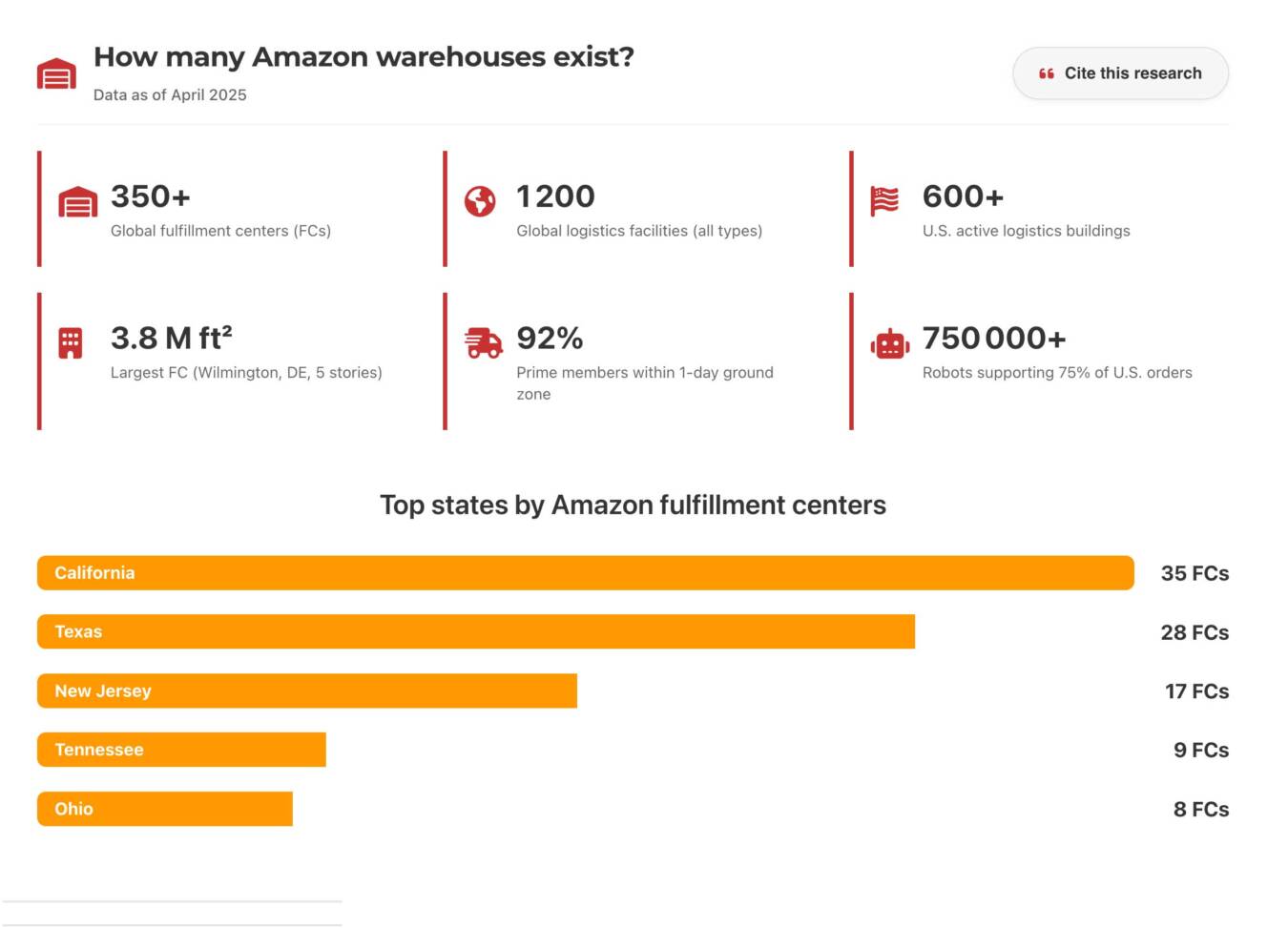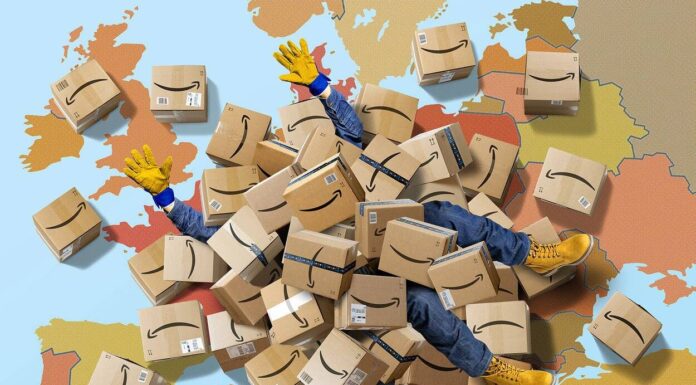Introduction
Amazon’s footprint in Europe has ballooned dramatically, blending economic boon with environmental controversy. According to Amazon’s own data, the company directly employs over 230,000 people across Europe in 2024, with 150,000 in the EU27, supporting more than 1 million jobs including indirect roles in logistics and construction [1]. Investments reached €55 billion in 2024, contributing €41 billion to European GDP [1]. Globally, Amazon operates around 1,200 logistics facilities, including 350 fulfillment centers and 550 last-mile stations, with a significant push in Europe [3]. In Germany alone, 20 fulfillment centers underpin a market projected at $126 billion in e-commerce sales by 2025 [2]. However, this expansion has sparked backlash, with groups like France’s Citizens’ Convention for Climate demanding moratoriums on new warehouses to curb emissions and ecosystem strain. As of October 2025, Amazon’s plans to integrate markets like the Netherlands into its Pan-European network underscore its logistical ambitions, even as sustainability questions loom [7].
Economic Growth Versus Environmental Costs
Amazon’s investments since 2010 total €320 billion in Europe, fostering economic revival in industrial heartlands [1]. A 2024 Keystone study, commissioned by Amazon, estimates €41 billion in GDP contributions and over 1 million supported jobs [1]. In the UK, detailed warehouse locations highlight expansions in key hubs [8], while pan-EU enhancements optimize cross-border logistics [7]. Yet, critics view this as “clearing the planet”—a metaphor for unchecked growth driving environmental harm. Independent analyses, such as Stand.earth’s July 2025 report, reveal Amazon’s direct emissions surged 162% since its 2019 Climate Pledge, with European warehouse booms contributing to higher energy demands [G13]. Posts on social media reflect public skepticism, with users accusing the company of greenwashing amid rising pollution from transportation.
Sustainability Claims Under Scrutiny
Amazon promotes its Climate Pledge for net-zero by 2040, investing in renewables and robotics to cut per-unit footprints [G1][G3]. Its 2024 Sustainability Report notes emissions per sales dollar dropped, with initiatives like EV fleets and recycled packaging [G5][G7]. However, absolute emissions rose 6% in 2024, per Bloomberg [G14], and Pacific Environment’s 2024 analysis ties U.S. trends to Europe’s logistics surge [G4]. Expert insights highlight a “growth paradox”: expansions undermine pledges without external checks. Activists on social media amplify calls for moratoriums, echoing the Citizens’ Convention’s push to pause developments for ecological reviews. Balanced views note Amazon’s automation reduces operational waste [3], but independent data questions overall impact [G6].

Activist Demands and Policy Responses
Citizen groups demand moratoriums on new warehouses near cities, citing land use changes and emissions [1]. In France, the Citizens’ Convention advocates halting mega-projects to align with Paris goals, with similar sentiments in Germany and the UK. Web reports indicate no EU-wide ban yet, but local protests have delayed builds [G2][G12]. Amazon counters with green innovations, like automated stock systems minimizing transport [4][7]. Emerging trends point to stricter EU reporting by 2026, potentially mandating scope 3 emissions tracking. Original insights suggest “citizen vs. corporation” shifts could yield hybrid models, such as community-approved facilities with carbon offsets.
Constructive Solutions and Future Pathways
Solutions include Amazon’s ongoing robotics for efficiency [3] and investments in green delivery [G3]. Experts propose regulatory pauses for environmental audits, alongside incentives for circular economies. Active pilots, like seaweed carbon farms, show promise. Policymakers could enforce localized fulfillment to cut emissions, blending growth with sustainability.
KEY FIGURES
- Amazon directly employs over 230,000 people across Europe in 2024, with 150,000 employees in the EU27 alone, supporting more than 1 million total jobs including indirect employment in logistics, construction, and infrastructure sectors (including 630,000 indirect jobs) (Source: Amazon official data) [1].
- Amazon invested €55 billion in Europe in 2024, part of a total of €320 billion since 2010, contributing an estimated €41 billion to European GDP (with €29 billion in the EU27) [1].
- Globally, Amazon operates about 1,200 logistics facilities as of early 2025, including roughly 350 fulfillment centers and 550 last-mile delivery stations, with a significant expansion in Europe through mega-warehouses and sorting centers [3].
- Amazon Germany alone features 20 fulfillment centers and benefits from a market projected to reach $126 billion in e-commerce sales by 2025, with 88% of Germans purchasing online [2].
RECENT NEWS
- In June 2025, Amazon made the Netherlands a mandatory fulfillment country in its Pan-European Fulfillment Network, requiring sellers to list products on Amazon.nl to continue benefiting from the program, reflecting Amazon’s expansion and logistical integration in Europe [7].
- Amazon announced plans to double its storage space in Europe by establishing numerous new projects, including mega-warehouses, sorting centers, and delivery agencies, despite citizen opposition demanding a moratorium on new warehouses and commercial zones on city outskirts [1] (implied by citizen movements and conventions).
- Amazon’s 2024 investment in European infrastructure and workforce signals a continued push to dominate the online retail market and logistics sector despite environmental and social concerns [1].
STUDIES AND REPORTS
- A 2024 economic impact study by Keystone, commissioned by Amazon, estimated that Amazon’s European activities contribute €41 billion to GDP and support over 1 million jobs (direct and indirect), highlighting Amazon’s role in local economic development but also raising questions about sustainability and urban expansion [1].
- Environmental and citizen groups, including the Citizens’ Convention for Climate, call for a moratorium on new warehouse developments and commercial zones near cities, citing Amazon’s rapid expansion as a driver of increased emissions, land use change, and pressure on local ecosystems (no direct study link, but widely reported in recent climate activism) [1].
TECHNOLOGICAL DEVELOPMENTS
- Amazon continues to develop its robotics and automation within fulfillment centers to increase efficiency and reduce operational footprint per unit shipped, with robotic fulfillment centers among the 350 global facilities [3].
- The Pan-European Fulfillment Network uses automated stock redistribution and logistics optimization to reduce delivery times and costs, with recent enhancements including the integration of new markets like the Netherlands into a seamless cross-border logistics system [7].
- Amazon is investing in last-mile delivery innovations, including expanding its network of 550+ delivery stations and exploring green delivery options, although the environmental impact of such a large network remains contested [3].
MAIN SOURCES
- https://www.aboutamazon.eu/news/job-creation-and-investment/hope-returns-to-europes-industrial-heartlands-amazons-320-billion-investment-story – Amazon’s economic impact and investment in Europe (2024)
- https://amzprep.com/best-amazon-european-expansion-countries/ – Market data on Germany and Amazon’s European expansion (2025)
- https://redstagfulfillment.com/how-many-amazon-warehouses-are-there/ – Current data on Amazon’s warehouse and logistics network (2025)
- https://www.aboutamazon.eu/delivering-the-future – Amazon Europe infrastructure and future plans (context)
- https://hellotax.com/blog/amazon-warehouse-locations-in-europe/ – Details on Amazon’s European warehouse locations
- https://www.youtube.com/watch?v=8RNBOSuJq1Y – Amazon Accelerate 2025 presentation on European market growth
- https://tbaglobal.com/amazon-pan-eu-expansion-netherlands-becomes-mandatory-in-june-2025/ – Details on Pan-EU expansion and Netherlands inclusion (2025)
- https://amzprep.com/europe/amazon-uk-warehouse-locations/ – Amazon UK warehouse specifics (2025)
This synthesis shows that Amazon’s rapid growth in Europe involves massive infrastructure investment, job creation, and market expansion, but also raises significant environmental and urban planning concerns, with citizen groups demanding regulatory action to limit new warehouse construction near cities.
Other references :
aboutamazon.eu – Hope returns to Europe’s industrial heartlands
amzprep.com – Best Amazon European Expansion Countries 2025 for Amazon Sellers
redstagfulfillment.com – How Many Amazon Warehouses Are There? (Updated for 2025)
aboutamazon.eu – Delivering the Future – Amazon Europe
hellotax.com – Amazon Warehouse Locations in Europe – hellotax
youtube.com – Amazon Accelerate 2025: From Local to Global – YouTube
tbaglobal.com – Amazon Pan-EU Expansion: Netherlands Becomes Mandatory in …
amzprep.com – Amazon UK Warehouse Locations Address List 2025 – AMZ Prep
sustainability.aboutamazon.com – Source
manufacturingdigital.com – Source
aboutamazon.eu – Source
pacificenvironment.org – Source
sustainability.aboutamazon.com – Source
statista.com – Source
sustainabilitymag.com – Source
technologymagazine.com – Source
procurementmag.com – Source
sustainabilityonline.net – Source
stand.earth – Source
bloomberg.com – Source
x.com – Source
x.com – Source
x.com – Source
x.com – Source
x.com – Source
x.com – Source



